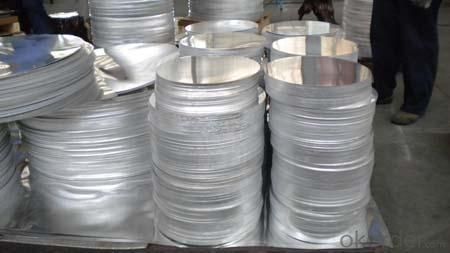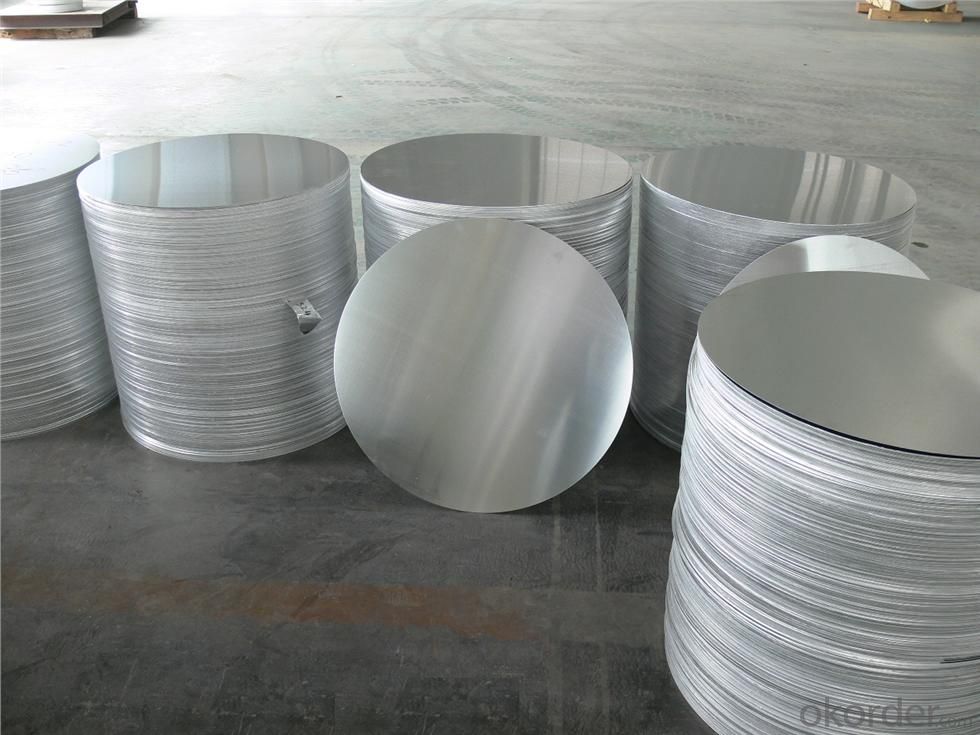Hot Rolled Aluminium Circles for Deep Drawing Cup
- Loading Port:
- Shanghai
- Payment Terms:
- TT or LC
- Min Order Qty:
- 2 m.t.
- Supply Capability:
- 50000 m.t./month
OKorder Service Pledge
OKorder Financial Service
You Might Also Like
Item specifice
1.Structure of Hot Rolled Aluminium Circles for Deep Drawing Cup
Hot Rolled Aluminium Circles for Deep Drawing Cup is one semi-finished aluminium material. This strip can be rolled down to aluminium coil,sheet,circle ect. The alloy AA1050 is widly used in building, industry ect. Its weight is much lower than steel. So many customers choosed aluminium material instead of steel.
2. Main features of Hot Rolled Aluminium Circles for Deep Drawing Cup
a.Competitive price---We have our own mills and can produce mill finished aluminium coils, so we can control the production cost better.
b.Professional after-sale service---We have more than 15 years exportation experience and you need not worry about the exporation problems.
c.Fast delivery time---We can control the delivery time within 35 days.
3. Image



4. Product Specification
| Alloy | Temper | Thickness | Width | Weight |
| AA3003 | H14 | 0.2MM-3MM | 1000MM-1800MM | 2 TONS |
5.FAQ:
What is the quality standard?
---Usually our standard is GB3880-2006
What is the largest width?
---It is 2300mm
What is the MOQ?
---Usually we can accept 80 tons.
- Q:Should I purchase a camper made out of aluminum/wood or a fiberglass?I'm looking to purchase a small camper, approx 18', to tow on the back of my SUV. It's a 2011 Wildwood camper. However, I hear campers made out of aluminum and wood aren't very good because the wood can ruin in time and the aluminum can rust, etc. I hear fiberglass campers are better? Anyone have any knowledge or experience with this? Also, any thoughts or advice with brands/models? And about the Wildwood? Thanks in advance.
- Aluminum is lighter so it offers economies over the life of the trailer. The Airstream has been built almost as long as I've been around. It is true that the wood does rot And some care is needed to stop the occasional leak. Fiberglass is heaver and has it's own maintenance issues. I've no experience with the Wildwood. What I do know is that motor homes are dirt cheap right now. You might think about taking advantage of the economy and pick-up a motor home at a bargain.
- Q:What's the maximum size of 3 mm thick aluminum sheet?
- See tolerance taggingIf there is no tolerance, see the accuracy level of the workpiece and check the tolerance listA 3-4 mm deviation is acceptable if the magnitude is not noted and is of no importanceThat is, the 3.5mm is OK, if the lower accuracy is generally 2.95
- Q:Can aluminum sheet be used for electrical grounding applications?
- Indeed, aluminum sheet finds utility in electrical grounding applications. It possesses remarkable conductive properties, rendering it apt for employment in grounding systems. Its low resistance and exceptional electrical conductivity make it a common choice in diverse electrical applications. With the capability to proficiently transport electrical current and securely disperse it into the ground, aluminum sheet guarantees the safeguarding of electrical systems and averts potential electrical dangers. Moreover, the lightweight and corrosion-resistant attributes of aluminum establish it as a favored option for grounding applications across numerous industries, encompassing construction, automotive, and aerospace.
- Q:How does the formability of aluminum sheet vary with different alloys?
- Variations in chemical composition and mechanical properties result in significant differences in the formability of aluminum sheet among different alloys. To enhance specific characteristics like strength, corrosion resistance, and formability, aluminum alloys are typically combined with elements such as copper, manganese, magnesium, and zinc. Aluminum alloys like the 1xxx series (pure aluminum) and the 3xxx series (manganese alloyed) are highly formable and commonly used for deep drawing applications. These alloys can be shaped into complex forms without cracking or tearing. In contrast, alloys with higher strength properties, such as the 2xxx series (copper alloyed) and the 7xxx series (zinc alloyed), generally have reduced formability. Although these alloys are often used in structural applications where strength is crucial, they require careful handling and processing to avoid defects during forming. Alloys in the 5xxx series (magnesium alloyed) offer a good balance of formability and strength. They are widely used in industries like automotive and aerospace, as they can be easily formed into different shapes while providing sufficient strength and corrosion resistance. It's important to note that the formability of aluminum sheet is not solely determined by the alloy composition. Other factors such as sheet thickness, forming temperature, and the specific forming process employed (e.g., deep drawing, bending, stretching) also influence formability. These factors interact with alloy properties to affect the formability characteristics of aluminum sheet. Therefore, careful selection of the appropriate alloy and process parameters is essential to achieve the desired formability for specific applications.
- Q:What are the different types of aluminum sheets?
- There are several different types of aluminum sheets available, each with its own unique characteristics and applications. Here are some of the most common types: 1. Plain aluminum sheet: This is the most basic type of aluminum sheet, characterized by its smooth surface and uniform thickness. It is widely used in various industries for general purposes. 2. Embossed aluminum sheet: This type of sheet has a textured or patterned surface, which is achieved by rolling the aluminum through a patterned roller. It is commonly used for decorative purposes, such as in interior design or automotive trim. 3. Perforated aluminum sheet: As the name suggests, this type of sheet contains small holes or perforations throughout its surface. It is often used in architectural applications, such as building facades or sunscreens, as well as in filtration systems. 4. Treadplate aluminum sheet: Also known as checker plate or diamond plate, this sheet has a raised pattern of lines or diamonds on its surface. This pattern provides added traction and makes it suitable for applications where slip resistance is important, such as industrial flooring or stair treads. 5. Anodized aluminum sheet: Anodizing is an electrochemical process that forms a protective oxide layer on the surface of the aluminum, making it more durable, corrosion-resistant, and able to accept dyes for color customization. Anodized aluminum sheets are commonly used in architectural applications, signage, and consumer products. 6. Painted aluminum sheet: This type of sheet is coated with a layer of paint, which not only enhances its appearance but also provides additional protection against corrosion. It is often used in applications where aesthetics are important, such as building facades, signage, or automotive parts. These are just a few examples of the different types of aluminum sheets available in the market. The choice of the right type depends on the specific requirements of the project, such as durability, appearance, corrosion resistance, or slip resistance.
- Q:What is the weight of aluminum sheets?
- The weight of aluminum sheets can vary depending on the thickness and dimensions of the sheet. As a general guideline, the weight of aluminum sheets can range from about 2.7 grams per square centimeter (g/cm^2) for thin sheets to around 6.9 g/cm^2 for thicker sheets. However, it is important to note that these values are approximate and can vary slightly depending on the specific alloy and manufacturing process used. Therefore, it is recommended to consult the manufacturer or supplier for precise weight specifications for a particular aluminum sheet.
- Q:I am trying to find a BRUSH ON type glue to adhere aluminium foil to a plastic model. scotch super 77 works great but dries way to fast and blows small pieces all over. white glue just dont work and superglue eats the plastic. I could use some help
- It seems very unlikely that any glue that requires evaporation of a substance (solvent, such as petroleum or other organic, water, etc.) is going to work gluing any but the smallest piece of foil to plastic (where it can cure from the foil edges). Neither the foil nor most plastics will allow evaporation from anywhere but the edges. A two part substance or an contact cement that you dry first before application would seem necessary.
- Q:Can the aluminum sheets be used for manufacturing light reflectors?
- Yes, aluminum sheets can be used for manufacturing light reflectors. Aluminum is a highly reflective metal and is commonly used in various industrial applications, including the production of light reflectors. Its high reflectivity allows it to efficiently redirect and amplify the light, making it an ideal material for manufacturing light reflectors for applications such as lighting fixtures, automotive headlights, solar panels, and photography equipment. Additionally, aluminum sheets are lightweight, durable, and corrosion-resistant, which further enhances their suitability for this purpose.
- Q:Can aluminum sheets be used for flooring?
- Yes, aluminum sheets can be used for flooring. Aluminum is a lightweight and durable material that can withstand heavy foot traffic and is resistant to corrosion. It is commonly used for industrial flooring, outdoor decks, and transportation platforms.
- Q:Can aluminum sheets be used for insulation?
- Indeed, insulation can make use of aluminum sheets. Given its excellent conductivity of heat and electricity, aluminum is capable of effectively reflecting and obstructing thermal energy. For instance, aluminum foil frequently serves as a radiant barrier in insulation setups. By redirecting radiant heat away from the structure, it aids in curtailing heat transfer and decreasing the influx or escape of heat through insulated regions. Moreover, aluminum sheets can also fulfill the role of a vapor barrier, thwarting moisture intrusion and thereby preserving the insulation's efficacy. In summary, aluminum sheets present a cost-effective and efficient alternative for insulation objectives.
1. Manufacturer Overview |
|
|---|---|
| Location | |
| Year Established | |
| Annual Output Value | |
| Main Markets | |
| Company Certifications | |
2. Manufacturer Certificates |
|
|---|---|
| a) Certification Name | |
| Range | |
| Reference | |
| Validity Period | |
3. Manufacturer Capability |
|
|---|---|
| a)Trade Capacity | |
| Nearest Port | |
| Export Percentage | |
| No.of Employees in Trade Department | |
| Language Spoken: | |
| b)Factory Information | |
| Factory Size: | |
| No. of Production Lines | |
| Contract Manufacturing | |
| Product Price Range | |
Send your message to us
Hot Rolled Aluminium Circles for Deep Drawing Cup
- Loading Port:
- Shanghai
- Payment Terms:
- TT or LC
- Min Order Qty:
- 2 m.t.
- Supply Capability:
- 50000 m.t./month
OKorder Service Pledge
OKorder Financial Service
Similar products
New products
Hot products
Related keywords






























